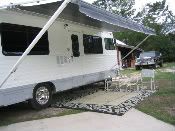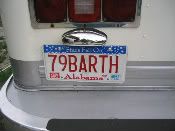Go to...  | Start A New Topic  | Search  | Notify  | Tools  | Reply To This Topic  |  |
 1/12 1/12 |
just got my carb back from zeda carbs in Texas and am going to replace the fuel pump with a better one and wanted to know the purpose of the return lines and are they necessary?I changed the carb fuel line from a front fuel inlet to side inlet and will be using stainless braided hose with AN Fittings . Any Thoughts???? Richard & Robin
| |||||
|
 3/11 3/11 |
The mechanical fuel pump pumps at a variable rate based on the rpm of the camshaft. The return line in the top of the pump provides a pressure relief so the input to the carb remains at 6 to 9 psi. If you install an electric pump with its internal switch you do not need a return, the pump operation is independent of the engine. On some 454 engines the tank plumbing is sealed and the return provides a vent function through the canister connection. The canister is operated by ported vacuum so it draws vapors out of the carb and recirculates them. If you have an older sealed fuel tank you do need one vent line to allow the tank to drain under operation. Or just get a vented gas cap and eliminate them. The better electric fuel pumps are almost bullet proof, maintain a constant pressure and are adjustable. You can get a block off plate at any race shop and most on line vendors such as Jegs and Summit. 1993 32' Regency Wide Body, 4 speed Allison Trans, Front Entry door, Diamond Plate aluminum roof & 1981 Euro 22' w Chevy 350 engine and TH 400 tranny | |||
|
 1/12 1/12 |
Is there one you would recommend ? I would much rather go that way and eliminate the mechanical all together. Richard & Robin
| ||||||
|
 1/12 1/12 |
I do still have twin tanks although i have considered removing one. Richard & Robin
| ||||||
|
| First Month Member |
The pressure of a mecahnical pump is determined by the spring. The cam lobe causes the arm to pull down on the diaphragm, sucking fuel from the input. The spring pushes the diaphragm back, forcing fuel out to the carb. The pressure is determined by the spring, but can be changed by changing the spring or its preload. The return line, while doing nothing for pressure is very useful to keep fuel moving to prevent vapor lock on the inlet line between the tank and the pump. It is sometimes called a vapor return line, for that reason. This is an important consideration on Pees with lines near the exhaust back there. GM had a mod where they routed larger fuel lines outboard of the frame rail to keep things cooler. A return line does nothing for vapor lock between the pump and carburetor, though.
My Carters and Holleys have no switch, but are mechanically regulated by a relief valve. The Facett on the genset has an internal switch, so it turns on and off as needed. The return line can still help, keeping the fuel moving through the line before it can overheat.
yup. The 502s in my Barth and ski boat have only electric pumps. The Barth has a 25 year old 6 psi Carter in back. So far, I have not had vapor lock issues, owing to good heat shielding done right after purchase, but future plans are a Holley high pressure pump in back and a regulator on the carb inlet. The higher pressure will give added vapor lock protection, and the Holley pump is field-rebuildable. The Carter can be repaired, but needs a grinder to disassemble it and some tie plate jiggery-pokery to get it back together. The Carter also runs wet, so it dislikes water. I am considering a return line to add a little extra protection, but it will throw off my fuel flowmeter/fuel used readings. A return line makes the electric pump work a little harder, so the extra volume is translated into velocity which reduces water pooling. With more alcohol in our fuel, this is becoming less of a concern than it used to be, however. Speaking of vapor lock and exhaust, I once had vapor lock in a gas tank, caused by a leaking tailpipe. While stopped and scratching my head, I could hear the gas in tank boiling. Galump, galump, etc. I had previously experienced this with jerrycans left in the desert sun, so the little light bulb came on in my mind, and a beer can was suitably modified to act as a heat shield. Never travel without baling wire and beer. I still lament the loss of cardboard six packs for gasket material. . 84 30T PeeThirty-Something, 502 powered | |||
|
| First Month Member |
Without a picture, I can't be sure, but you could be getting the fuel line into a hotter area. The OEM front line keeps it away from the hot exhaust and in good air flow. I would worry about heat damage to a rubber line directly above an exhaust manifold. Running, there would be decent air flow, but heat soak after shut down is a killer of rubber things and starter solenoids. If you must use a side line, it should be heat shielded hard steel, with a good (but short) flex line down below at the frame rail, far from exhaust heat. A number of race associations limit the use of flexible fuel line. I don't remember if they make a distinction between rubber and stainless braid over rubber or not. Lots of the braided line nowadays comes from China, and their rubber does not take heat or age well. I would buy my flex line from an aircraft source, and pay attention to quality and heat figures than the prettiness of the braid. www.Aircraftspruce.com is a good source. Or a good race shop like Pelican. . 84 30T PeeThirty-Something, 502 powered | |||
|
| Powered by Social Strata |
| Please Wait. Your request is being processed... |
|
This website is dedicated to the Barth Custom Coach, their owners and those who admire this American made, quality crafted, motor coach.
We are committed to the history, preservation and restoration of the Barth Custom Coach.
We are committed to the history, preservation and restoration of the Barth Custom Coach.



